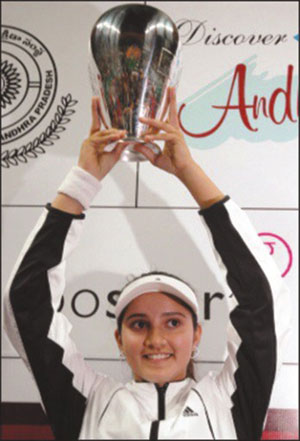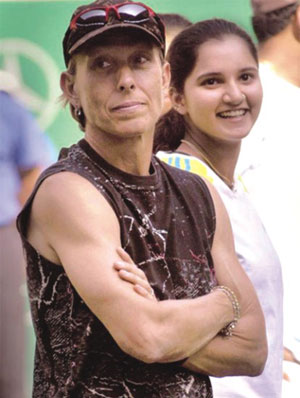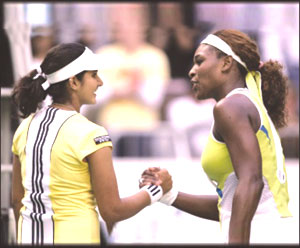| |
Sania Mania
Packing a stinging forehand, Sania Mirza has from out of nowhere blasted her way
to court, becoming the first Indian to win a WTA title. She’s serving up some
more
By V Krishnaswamy
Till a few months ago, not even Sania Mirza would have envisaged the change in
her life. A third-round performance in her first Grand Slam appearance, a WTA
title, bodyguards surrounding her, fans screaming for her, meetings with the
Prime Minister and President and a flurry of offers for endorsements. At the
start of the year, when she got a wild card for the Australian Open, her only
aim seemed to be to win a round and by the end of the year try and get into the
top 100.
 |
|
Even that seemed a tall order,
for no Indian woman tennis player had ever achieved that. Yet, within six weeks,
she had reached the third-round of the Australian Open and then to prove that it
was not a fluke, she won round after round with her thigh strapped and went on
to win a WTA title at home. And when the rankings came, she had just squeezed
into the top 100, and was placed at 99. It was nothing short of a fairy tale.
And it seems to be getting better, as companies see her as the next youth icon.
Alyque Padamsee, the ad guru was quoted as saying, “Not since PT Usha has India
had a female sports star of this calibre. Sania is young and hasn’t yet achieved
her full potential. So I feel she is an advertiser’s dream. She can become a
superstar and an icon for the youth… Soon, there will be ‘Sania mania’ sweeping
the land!’ It has already begun to happen. She is all over the front pages. And
soon she should be on the billboards and all that investment her father, Imran
Mirza, made while making her a tennis star, could be paying back rich dividends.
Sania’s is a story that could not have been scripted. Her parents, devout
Muslims, were in Mecca on a Haj pilgrimage and she was playing in a Grand Slam.
And then she won in front of her home crowd.
|
She is being seen as a role model for the young. Her good
looks, fresh and smiling face, her gutsy performances on the court and her
down-to-earth charm make her a dream model. She has been appointed ambassador of
the ‘Save the Girl Child’ campaign of the ministry of health and family welfare
in a country where female infanticide is common. And at the same time, as a devout Muslim she has shown how
strong Indian foundations are as a secular society as the whole nations rises as
one to applaud her.
|
The chairman believes there is
no reason why Air-India should not be the best airline in the world. After all,
in the fifties and the sixties, the Maharajah was a synonym for exclusivity. “To
attain those heights will require team effort. I will focus on building the team
first,” he says. The chairman started involving the middle management in the
day-to-day operations of the carrier. He also started talking with the unions.
In an industry where service is paramount, he stressed the need for the unions
to get their act together. “Based on the discussions, we have formed short
(3-year), medium (5-year) and long-term (7-year) plans.”
Sania’s family is religious. The members pray five times a day, read the Koran
and observe fast during Ramzan. Imran Mirza and his wife, Naseema, are both
graduates. A sports journalist-turned-printer-turned-builder, Imran, gave it all
as he promoted his daughter’s talent in tennis. She has quite a few sponsors
like G.V.K. Reddy, Atlas Cycles, Tata Tea and Sports Authority of Andhra Pradesh
and more are on the way. |
|
 |
|
Going back to the beginning,
she was born on November 15, 1986. A student of Hyderabad’s Nasr School, Sania
started playing tennis at the age of six. And from the
very start, she has had a strong forehand, something
that came out so well in her recent performances.he went through her paces in
age-group tennis, but in a country obsessed with cricket, she hardly made any
ripples. It was in 2001, that she joined the Bhupathi-Nike Academy in Bangalore.
That’s where the coaches worked on her backhand to make her a complete player. |
|
 |
At 14 years and a few months,
she got an entry into the 2001 Wimbledon Championships in the junior section.
She was the youngest in the junior girls’ competition. No, she did not set the
Thames on fire, but she was on a learning mission. She partnered Leander Paes to
pick up an Asian Games bronze in 2002 in the mixed doubles in Busan, South
Korea, and then won two gold medals in the National Games at Hyderabad. Then
followed an Asian under-18 title. Even as she plied her trade in satellite
tennis and Tier III and IV tournaments, she won her biggest prize in 2003, when
she won Wimbledon girls’ doubles title partnering Russian Alisa Kleybanova. She
had already set a new benchmark for Indian women’s tennis.
 |
|
Even that seemed a tall order,
for no Indian woman tennis player had ever achieved that. Yet, within six weeks,
she had reached the third-round of the Australian Open and then to prove that it
was not a fluke, she won round after round with her thigh strapped and went on
to win a WTA title at home. And when the rankings came, she had just squeezed
into the top 100, and was placed at 99. It was nothing short of a fairy tale.
And it seems to be getting better, as companies see her as the next youth icon.
Alyque Padamsee, the ad guru was quoted as saying, “Not since PT Usha has India
had a female sports star of this calibre. Sania is young and hasn’t yet achieved
her full potential. So I feel she is an advertiser’s dream. She can become a
superstar and an icon for the youth… Soon, there will be ‘Sania mania’ sweeping
the land!’ It has already begun to happen. She is all over the front pages. And
soon she should be on the billboards and all that investment her father, Imran
Mirza, made while making her a tennis star, could be paying back rich dividends.
Sania’s is a story that could not have been scripted. Her parents, devout
Muslims, were in Mecca on a Haj pilgrimage and she was playing in a Grand Slam.
And then she won in front of her home crowd.
|
|
She is being seen as a role
model for the young. Her good looks, fresh and smiling face, her gutsy
performances on the court and her down-to-earth charm make her a dream model.
She has been appointed ambassador of the ‘Save the Girl Child’ campaign of the
ministry of health and family welfare in a country where female infanticide is
common.
And at the same time, as a devout Muslim she has shown how strong Indian
foundations are as a secular society as the whole nations rises as one to
applaud her. Sania’s family is religious. The members pray five times a day,
read the Koran and observe fast during Ramzan. Imran Mirza and his wife, Naseema,
are both graduates. |
|
 |
A sports journalist-turned-printer-turned-builder,
Imran, gave it all as he promoted his daughter’s talent in tennis.She has quite a few sponsors
like G.V.K. Reddy, Atlas Cycles, Tata Tea and Sports Authority of Andhra Pradesh
and more are on the way. Going back to the beginning,
she was born on November 15, 1986. A student of Hyderabad’s Nasr School, Sania
started playing tennis at the age of six. And from the
very start, she has had a strong forehand, something
that came out so well in her recent performances. He went through her paces in
age-group tennis, but in a country obsessed with cricket, she hardly made any
ripples. It was in 2001, that she joined the Bhupathi-Nike Academy in Bangalore.
That’s where the coaches worked on her backhand to make her a complete player.
At 14 years and a few months, she got an entry into
the 2001 Wimbledon Championships in the junior section. She was the youngest in
the junior girls’ competition. No, she did not set the Thames on fire, but she
was on a learning mission. She partnered Leander Paes to pick up an Asian Games
bronze in 2002 in the mixed doubles in Busan, South Korea, and then won two gold
medals in the National Games at Hyderabad. Then followed an Asian under-18
title. Even as she plied her trade in satellite tennis and Tier III and IV
tournaments, she won her biggest prize in 2003, when she won Wimbledon girls’
doubles title partnering Russian Alisa Kleybanova. She had already set a new
benchmark for Indian women’s tennis. Winning two rounds at the Australian
Open this year was another first for an Indian woman. Before her only Nirupama
Vaidyanathan had won a round at a Slam. And she played gutsy tennis against the
eventual champion, Serena Williams, then ranked seventh in the world.
No sooner had the din died
down, Sania was given a wild card at the Hyderabad Open WTA tournament promoted
by Mahesh Bhupathi, whose company Globosport has taken on Sania. The player, who
rose to 131 after her Australian Open exploits, lived up to the hopes of the
organisers who gave her a wild card. Fighting an ankle injury, she went through
round after round and in a story that became more and more enchanting with each
passing day, she went on to win the title itself. She was running more on
adrenaline, as the injury worsened, forcing her to pull out of the following
week’s WTA event in Bogota.
But in the process, she became the first Indian to win a WTA title, proving her
historic run at the Australian Open was no fluke. She completed a brilliant run
at the Hyderabad Open by beating Alyona Bondarenko of the Ukraine 6-4 5-7 6-3 in
the final. A year ago, she became the youngest Indian to win a professional
title by claiming the doubles at the Hyderabad Open.
“It is a big moment in my career and I would like to thank everyone who has been
a part of my effort,” she said. “This win has made me believe more in myself and
I can now hope to do better in the coming days. I wanted to win this tournament
very badly since it was in my hometown.” If on the eve of the tournament she had
said she wanted to win the tournament, it would have been seen as tall talk. But
no longer. The nation believes in her as much she believes in herself. Sania
Mirza has indeed arrived
|
|